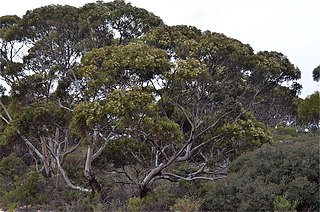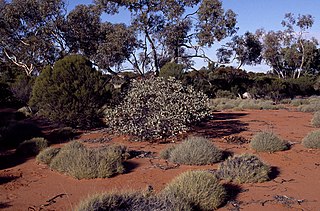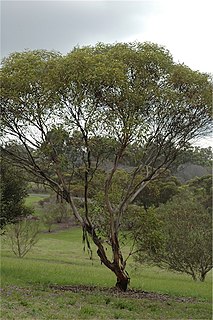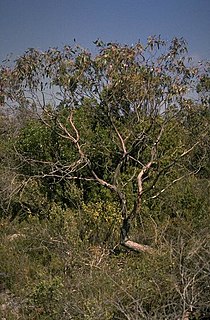
Eucalyptus lansdowneana, commonly known as the crimson mallee or the red-flowered mallee box, is a species of slender stemmed, straggly mallee that is endemic to a restricted area of South Australia. It has rough, fibrous or flaky bark at the base, smooth, grey over creamy-white bark, lance-shaped adult leaves, flower buds in groups of seven, crimson flowers and barrel-shaped fruit.

Eucalyptus fasciculosa, commonly known as pink gum, hill gum or scrub gum, is a species of small tree that is endemic to southern Australia. It has mostly smooth, light grey to pinkish bark, lance-shaped adult leaves, flower buds in groups of seven, white flowers and conical to barrel-shaped fruit.

Eucalyptus foecunda, commonly known as narrow-leaved red mallee, Fremantle mallee or coastal dune mallee, is a species of plant in the myrtle family that is endemic to Western Australia. It has rough bark on the trunk, smooth bark above, narrow lance-shaped adult leaves, flower buds in groups of nine or eleven, creamy white flowers and cup-shaped fruit. It was previously included with the more widespread Eucalyptus leptophylla.

Eucalyptus gracilis, commonly known as yorrell or white mallee, is a species of mallee or small tree endemic to Australia, where it is found in south-western New South Wales], Victoria, South Australia and Western Australia. It has smooth white bark, usually with rough, fibrous or flaky bark on the lower stems, linear to narrow lance-shaped adult leaves, flower buds in group of between seven and eleven and cup-shaped, cylindrical or barrel-shaped fruit.

Eucalyptus socialis, commonly known as the red mallee, or grey mallee, is a species of mallee that is endemic to inland Australia.

Eucalyptus gongylocarpa, commonly known as baarla, marble gum or desert gum, is a species of tree endemic to central Australia. It has smooth bark, lance-shaped to elliptical leaves arranged more or less in opposite pairs, flower buds in groups of seven, whitish flowers and more or less spherical fruit.
Eucalyptus gypsophila, also known as the kopi mallee, is a species of mallee that is native to Western Australia and South Australia. It has rough, flaky bark on the lower part of the trunk, smooth light grey bark above, lance-shaped adult leaves, flower buds mostly in groups of between seven and eleven, creamy white flowers and conical to cylindrical fruit.

Eucalyptus mannensis, commonly known as Mann Range mallee, is a species of mallee that is native to Western Australia, South Australian and the Northern Territory. It has rough bark at the base of the trunk, smooth bark above, narrow lance-shaped adult leaves, flower buds in groups of between seven and eleven, creamy white flowers and hemispherical fruit.
Eucalyptus phenax, commonly known as green dumosa mallee or white mallee, is a species of mallee that is endemic to southern Australia. It has smooth bark, lance-shaped adult leaves, flower buds in groups of seven or nine, white flowers and cup-shaped to cylindrical fruit.

Eucalyptus pimpiniana, commonly known as the pimpin mallee, is a species of shrubby mallee that is endemic to the Great Victoria Desert of South Australia and Western Australia. It has smooth, mottled bark, lance-shaped adult leaves, flower buds in group of between seven and nineteen, yellow flowers and cylindrical to barrel-shaped fruit.
Eucalyptus repullulans, commonly known as chrysoprase mallee, is a species of mallee that is native to arid parts of Western Australia and the far north-west of South Australia. It has smooth bark, lance-shaped adult leaves, flower buds in groups of between seven and thirteen, cream-coloured flowers and cup-shaped, cylindrical or conical fruit.

Eucalyptus sparsa, commonly known as the northern ranges box, is a species of mallee that is endemic to inland Australia, near the border between the Northern Territory, South Australia and Western Australia border. It has smooth pale grey and brown bark, often with rough bark on the base of larger trunks, lance-shaped adult leaves, flower buds usually in groups of seven, white flowers and shortened spherical to conical fruit.

Eucalyptus striaticalyx, commonly known as Cue York gum or kopi gum, is a species of tree or mallee that is endemic to Western Australia. It has thick, rough, fibrous bark on the trunk and larger branches, lance-shaped adult leaves, flower buds in groups of between seven and thirteen, creamy white flowers and conical to cup-shaped fruit.

Eucalyptus calcareana, commonly known as the Nundroo mallee or Nundroo gum, is a mallee or a small tree that is endemic to the south coast of Australia. It has smooth, greyish or cream-coloured bark, lance-shaped or curved adult leaves, flower buds in groups of seven or nine, creamy-white flowers and cup-shaped to conical fruit.

Eucalyptus arcana, commonly known as the Mallee manna gum or Carpenter Rocks gum is a mallee that is endemic to South Australia. It has rough bark from the base of the trunk to the thinnest branches, lance-shaped, sometimes curved leaves, flower buds in groups of seven, white flowers and hemispherical fruit. It is only known from a single population near Carpenter Rocks.
Eucalyptus paludicola, commonly known as Mount Compass swamp gum, marsh gum or Fleurieu swamp gum, is a species of small tree that is endemic to the south-east of South Australia. It has smooth bark, lance-shaped or curved adult leaves, flower buds usually in groups of seven, creamy white flowers, and cylindrical, conical or bell-shaped fruit. It is only known from the Fleurieu Peninsula and Kangaroo Island.

Eucalyptus alatissima is a mallee that is endemic to central parts of the Great Victoria Desert. It has rough bark on the lower part of its stems, smooth tan to cream-coloured bark on its upper parts, egg-shaped to lance-shaped leaves and buds in groups of three. The buds have a powdery covering and are prominently winged.

Eucalyptus canescens, commonly known as the Ooldea Range mallee or Beadell's mallee, depending on subspecies, is a species of mallee that is endemic to southern Australia. It has rough bark from the base of the trunk to the thicker branches, smooth bark on the thin branches, egg-shaped to lance-shaped adult leaves, flower buds in groups of between seven and eleven, creamy white flowers and smooth cup-shaped to conical, and sometimes ribbed fruit.
Eucalyptus ecostata, commonly known as coastal silver mallee, is a species of mallee that is endemic to the south coast of Western Australia. It has smooth greyish bark, lance-shaped to curved adult leaves, flower buds in groups of between eleven and fifteen, creamy white flowers and more or less hemispherical but flattened fruit.

Eucalyptus socialis subsp. eucentrica, commonly known as the inland red mallee, is a subspecies of mallee that is endemic to inland Australia. It usually has rough bark on the base of the trunk, smooth bark above, lance-shaped adult leaves, flower buds in groups of between seven and eleven, pale creamy yellow flowers and barrel-shaped to urn-shaped or spherical fruit.
















